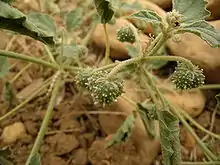Chrozophora tinctoria
Chrozophora tinctoria (commonly known as dyer's croton,[2] giradol,[2] or turnsole[2]) is a plant species native to the Mediterranean, the Middle East, India, Pakistan, and Central Asia.[1][3][4][5] It is also present as a weed in North America and Australia.[6]
| Dyer's croton | |
|---|---|
 | |
| Scientific classification | |
| Kingdom: | Plantae |
| Clade: | Tracheophytes |
| Clade: | Angiosperms |
| Clade: | Eudicots |
| Clade: | Rosids |
| Order: | Malpighiales |
| Family: | Euphorbiaceae |
| Genus: | Chrozophora |
| Species: | C. tinctoria |
| Binomial name | |
| Chrozophora tinctoria | |
| Synonyms[1] | |
| |
Description
It is an annual, typically found in nutrient-poor ground. It develops a large taproot.[6] The plant is erect and covered with wool-like hairs.[7] The ash-green leaves are alternate. The tiny monecious flowers are grouped in a raceme. The lower, female flowers lack petals and the upper male flowers have five small yellow petals. Pollination is by ants.[6] The fruits are conspicuous and consist of three dark green conjoined spheres. Their surface is decorated with white scales and warty structures. Each sphere contains three seeds, which are propelled away from the plant by the mechanical force of the mature fruit twisting as it opens.[6]
Use for dye
Chrozophora tinctoria produced the blue-purple colorant "turnsole" (also known as katasol[8] or folium[7] ) used in medieval illuminated manuscripts and as a food colorant in Dutch cheese and certain liquors.[9] The colour comes from the plant's fruit, specifically its dry outer coat.[8]
In 2020, an interdisciplinary team of researchers from FCT NOVA, University of Porto and University of Aveiro, identified the complex chemical structure of the medieval purple-blue dye extracted from the fruits of Chrozophora tinctoria.[7] The chemical structure of the medieval dye was a mystery until now.[7] The extracts obtained showed a novel blue chemical, chrozophoridine as the main chromophore.[7][10]
References
- Kew World Checklist of Selected Plant Families
- "Chrozophora tinctoria". Germplasm Resources Information Network (GRIN). Agricultural Research Service (ARS), United States Department of Agriculture (USDA). Retrieved 3 December 2012.
- Altervista Flora Italiana, Tornasole comune, Turn Sole, tournesol, tornasol, Lackmuskraut, Chrozophora tinctoria (L.) A. Juss.
- Zervous, S., Raus, T. & Yannitsaros, A. (2009). Additions to the flora of the island of Kalimnos (SE Aegean, Greece). Willdenowia 39: 165-177.
- Dobignard, A. & Chatelain, C. (2011). Index synonymique de la flore d'Afrique du nord 3: 1-449. Éditions des conservatoire et jardin botaniques, Genève.
- Mifsud, Stephen. "Chrozophora tinctoria (Dyer's Litmus)". Wild Plants of Malta. Retrieved 22 April 2020.
- Nabais, P.; Oliveira, J.; Pina, F.; Teixeira, N.; de Freitas, V.; Brás, N. F.; Clemente, A.; Rangel, M.; Silva, A. M. S.; Melo, M. J. (April 2020). "A 1000-year-old mystery solved: Unlocking the molecular structure for the medieval blue from Chrozophora tinctoria , also known as folium". Science Advances. 6 (16): eaaz7772. doi:10.1126/sciadv.aaz7772. ISSN 2375-2548. PMC 7164948. PMID 32426456.
- Melo, Maria J.; Castro, Rita; Nabais, Paula; Vitorino, Tatiana (2018). "The book on how to make all the colour paints for illuminating books: unravelling a Portuguese Hebrew illuminators' manual". Heritage Science. 6: 44. doi:10.1186/s40494-018-0208-z.
- Chrozophora, Folium cloth
- "1000-Year-Old Mistery Unfolded With The Discovery Of Medieval Blue Dye Structure". Universidade Nova de Lisboa. Retrieved 22 April 2020.